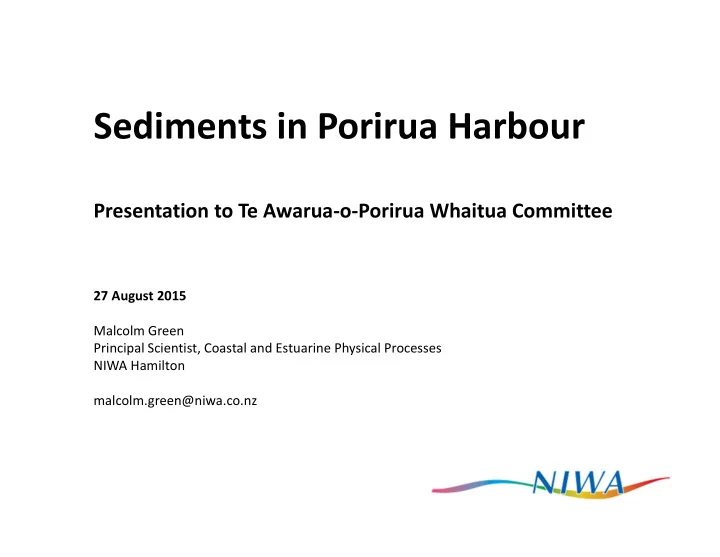

Sediments in Porirua Harbour Presentation to Te Awarua-o-Porirua Whaitua Committee 27 August 2015 Malcolm Green Principal Scientist, Coastal and Estuarine Physical Processes NIWA Hamilton malcolm.green@niwa.co.nz
The origin of Porirua Harbour
The origin of Porirua Harbour Marine sediments Image: Google. Terrestrial sediments
The components of Pauatahanui Inlet Fluvial delta (Kakaho Stm) Intertidal flats Fluvial delta (Horikiri Stm) Spit Flood-tide delta Intertidal flats Central mud basin Saltmarsh Throat Intertidal flats Intertidal flats Tidal creek (Pauatahanui Stm)
The components of Onepoto Throat Flood-tide delta Central mud basin Intertidal flats Fluvial delta
There are two different types of sediment problem in Porirua Harbour…
Problem (1) Flood-tide delta navigability Fluvial delta Intertidal flats Fluvial delta Spit Flood-tide delta Intertidal flats Central mud basin Saltmarsh Throat Intertidal flats Intertidal flats Tidal creek
Problem (2) Terrestrial sediment inputs have got bigger Marine sediments Image: Google. Terrestrial sediments
This is essentially about the natural variability of the flood-tide delta…. …. but this is about catchment management .
The size of the problem 7.9 mm/year 4.1 mm/year 8.1 mm/year 4.5 mm/year 4.9 mm/year 10.7 mm/year 15.2 mm/year 7.9 mm/year 14.2 mm/year 7.0 mm/year Sedimentation rate over the period 1974 to 2009, estimated from bathymetric surveys. Gibb and Cox, 2009; 2011.
The size of the problem Pre-catchment-disturbance sedimentation rate 0.1-1 mm/year 7.9 mm/year 4.1 mm/year 8.1 mm/year 4.5 mm/year 4.9 mm/year 10.7 mm/year 15.2 mm/year 7.9 mm/year 14.2 mm/year 7.0 mm/year Sedimentation rate over the period 1974 to 2009, estimated from bathymetric surveys. Gibb and Cox, 2009; 2011.
Consequences Ecological
Consequences ROSS GIBLIN/Fairfax NZ Human amenity • Reduction in clarity – contact recreation, aesthetics • Shoaling • Change in underfoot condition • Shellfish gathering • Mauri Geomorphological • Premature loss of the harbour
By how much do we need to reduce the terrestrial sediments to make a difference?
There are any number of attributes that we could set targets or objectives around… Frequency of smothering events Visual clarity Seabed muddiness Light penetration Sediment deposition rate Suspended-sediment concentration
… but, this far, we have chosen an average annual sedimentation rate for a target because: • Measurable • Easy to understand and explain • Sets the foundation for management of the catchment • Anticipate that a range of co-benefits will be delivered on the back of the average annual sedimentation rate Also, there is a rationale for coming up with a specific target…
Pre-catchment-disturbance: 0.1-1 mm/year Today: 7.9 mm/year 4.1 mm/year 8.1 mm/year 4.5 mm/year 4.9 mm/year 10.7 mm/year 15.2 mm/year 7.9 mm/year 14.2 mm/year 7.0 mm/year Target: 1 mm/year
What do we now do with that target? • Back-calculate catchment sediment runoff that will achieve the sedimentation target • Call this the sediment (runoff) limit • Work out how to arrange and conduct activities in the catchment so that the limit is not exceeded • Implement those arrangements • Monitor to check that: o the sediment runoff limit is not being exceeded o the target sedimentation rate is being achieved o the co-benefits are being delivered on the back of the target sedimentation rate � If not, go back and figure out why, and fix it.
Catchment sediment runoff limits will also be required to provide for freshwater ecosystem health and human amenity values... … it is crucial that these be matched with the catchment sediment runoff limit that is required to achieve the estuary sedimentation target.
Good luck.
Recommend
More recommend